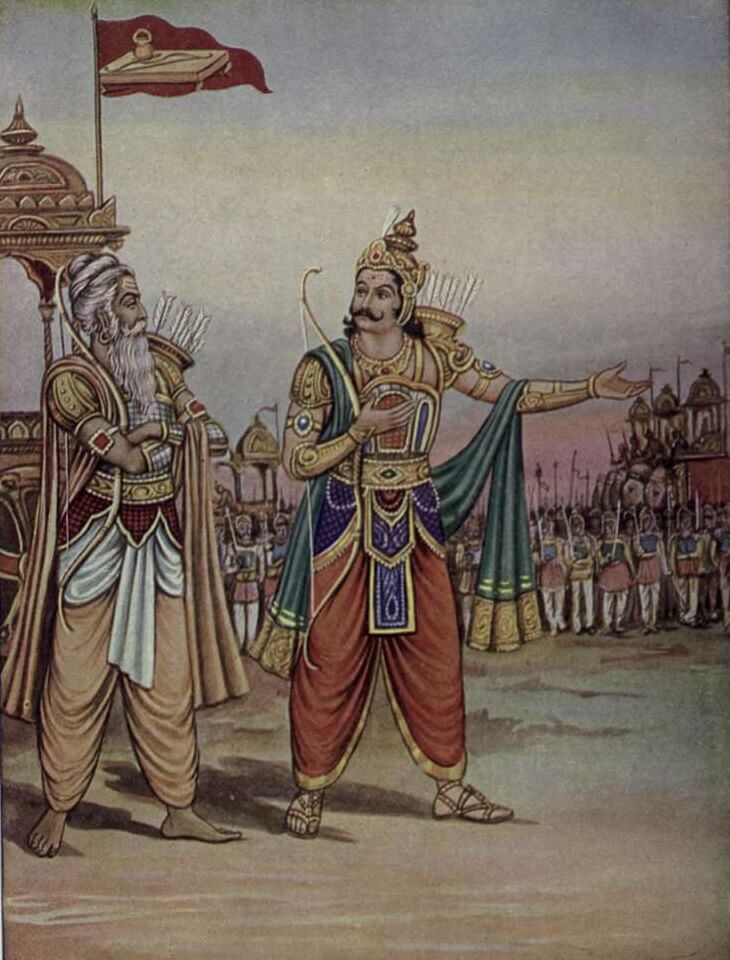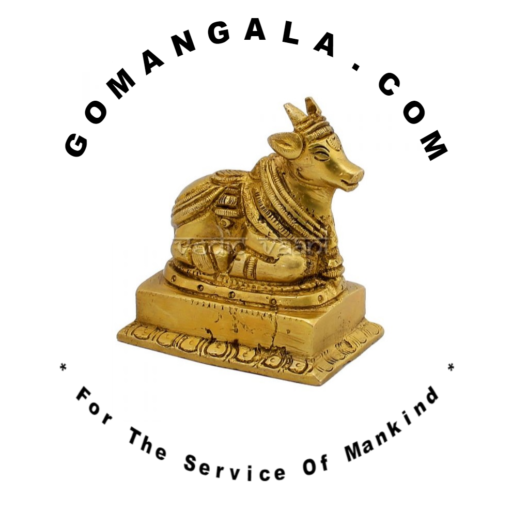Dronabhisheka Parva is the sixty fifth Upa parva included in the seventh Maha parva named as Drona parva. Vaishampayana continued narration to Janamejaya in reply to his queries as follows.
After Bhishma had fallen, who had been suggested to be the commander-in-chief for Duryodhana side army and by whom?
On the eleventh day morning, Karna had visited Duryodhana with his bow and quiver full of arrows along with reserve stock in his chariot, loyally seeking permission to take an active part in the war to satisfy Duryodhana. Duryodhana was very happy and the other soldiers of his regiment also felt overjoyed. So he approached Bhishma for his permissions.

To his surprise, he found Arjuna prostrating before Bhishma there. Bhishma was lying on the bed of arrows. That site was at the side of Kurukshetra battle ground. Duryodhana had managed to dig the protective trenches around Bhishma to the satisfaction of Bhishma. Then Karna suggested Duryodhana to install Drona as the next commander-in-chief for the Duryodhana side army. It was accomplished by Duryodhana immediately.
What Arjuna had done on the eleventh day morning?
With Yudhishtira and other brothers, Arjuna had visited Bhishma in the early morning. Arjuna prostrated before Bhishma and enquired about his comforts but immediately found Karna also behind him. Bhishma had requested Arjuna for drinking water where he was laid up in the battlefield. Arjuna started to fix his bow with some special arrow with concentration on himself. Karna observed him.
Why Arjuna used Parjanyastra similar to Shree Rama in Tretayuga?
Arjuna used Parjanyastra similar to Shree Rama who used it in Tretayuga and water sprang from the field, directly pouring into the mouth of Bhishma. Duryodhana was observing the scenes as a dumbstruck witness. Karna was also an expert in using Parjanyastra but he kept silent and preserved his stock of it for future use, which was later used in a fight with Ghatotkacha.
In the Ghatotkacha Parva of this website, more would be seen about Karna using it but Karna had not succeeded by using it with Ghatotkacha. Later, Karna used his most powerful Vasavi Astra obtained as a boon from Indra previously, which was being secretly preserved for killing Arjuna .
How Bhishma advised Duryodhana on the eleventh day morning?
Bhishma knew many items. He advised Karna to proceed with his life ambitiously and of sharing happiness with Duryodhana. He advised Duryodhana not to hate Yudhishtira but to treat him as a loving brother. He assured Duryodhana about Yudhishtira, and to forget every events till the previous day and start a new life peacefully. He advised it is better to end the war with the end of Bhishma himself then and there.
Bhishma had explained and differentiated both Arjuna and Karna to Duryodhana. With Karna, he advised to rule the entire world, being the eldest of Pandavas. Karna told he knew it but if the throne of the emperor if at all was offered to him, he would donate it to Duryodhana as a faithful friend of him. He knew the end would be death for all and hence he would fight sincerely for the happiness of Duryodhana.
Karna was able to aim at the clouds and his Parjanyastra would cause rain, but Arjuna had aimed his arrow towards the ground and Arjuna’s arrow caused pouring ground water to his mouth. But the difference between the capabilities of Arjuna and Karna could not be understood by Duryodhana and they left the place, deciding further fighting would be under the commander-in-chief as Drona
What Karna had done on the eleventh day morning?
Karna was the faithful friend of Duryodhana. When Bhishma had fallen, Karna was alerted. He took his weapons and started to follow Drona on the eleventh day early morning of the war. Since Karna had got his permission from Bhishma, the soldiers under Drona enjoyed and were indirectly encouraged in the battlefield to move against Pandavas. Karna had suggested Duryodhana to make Drona as their chief warrior, the commander-in-chief for Duryodhana’s army regiment.
What Duryodhana had done on the eleventh day morning?
Duryodhana met with Bhishma, prostrated and begged for success in the war. But Bhishma advised Duryodhana not to hate Yudhishtira but to treat him as a loving brother. Bhishma had explained and differentiated both Arjuna and Karna to Duryodhana. Since using Parjanyastra was known to Karna, Duryodhana desired to proceed with war including Karna.
As per the wish of Karna, in front of Bhishma, Duryodhana had installed Drona as the chief and the entire troops of soldiers loudly applauded and ran to the battlefield. A comfortable tent was arranged where Bhishma was laying and the war field had been shifted to a safer distance away from him.
What Bhishma had expected in his arrows-bed in the battlefield?
Bhishma had been expecting his auspicious death time. He desired the approach of the Uttarayana. So without accepting any medicine, but with practice of yoga, he was lying there alone for more than sixty days anticipating the time for a good death.
What are the various Upa parvas under Drona Maha parva?
The seven different Upa parvas under Drona Maha parva are as follows.
- Abhimanyu parva
- Samasaptaka parva
- Pratijna parva
- Jayadratha Vadha parva
- Drona Vadha parva
- Ghatotkacha parva
- Narayanastra parva
The important contents and events are as follows.
Abhimanyu vadha was managed by Drona under the warrior Jayadratha on the eleventh day by forming the Chakravyuha. The seven super power warriors of Trigarta had fought day and night on the twelfth day of the war. Pandava side army faced the war very bravely. On the twelfth day, five out of seven Trigarta warriors had been killed in day time and the remaining two were killed in the night war. Ghatotkacha was also killed in the twelfth night war by Karna. Drona could not be killed during day time but Jayadratha could be killed during day time.
Krishna and Satyaki had advised Yudhishtira to arrange the war as per feasible modes to get success. Satyaki was fighting with Karna on the thirteenth day only to make Karna tired and keep away from both Jayadratha and Drona. Since Jayadratha along with his troops had formed Chakravyuha to trap Abhimanyu, and Karna had stabbed with a shaft from behind, the young Abhimanyu had died but Arjuna was feeling very sorry due to the incident.
Hence, Arjuna took an oath to kill Jayadratha before the sun set of the thirteenth day evening. It was declared as Pratijna with drum beatings when Ghatotkacha was killed by Karna using his Vasavi Astra. The loud sound was heard by the army intelligence of Duryodhana and later that news reached the ears of Jayadratha. This Prathijna parva was a challenge for Krishna and Duryodhana. Under the moon light of the thirteenth night war, Drishtadyumna had killed Drona. Thereafter, Sanjaya visited Dritarashtra for reporting the real past war events.
Who was installed after Drona died?
Karna was installed as the commander-in-chief for Duryodhana’s army. He had led the army but Karna also died on the fifteenth day evening by the arrows of Arjuna. For the sixteenth and seventeenth day of war, Shalya was installed as the commander-in-chief for Duryodhana’s army.
Since there was no commander-in-chief on the seventeenth day evening, Duryodhana had escaped into the water tank but there was a massacre violence by Ashwathama only to satisfy Duryodhana after self-proclaiming as commander-in-chief for Duryodhana’s side. Kritavarma was put as external security for Hastinavati Palace and Kripa was a safety officer for the throne and treasury of Dritarashtra.
Ashwathama had persuaded Kripa and Kritavarma to act as commandos for himself. It was not a war but an illegal violence forced by the malicious desire of Ashwathama. Later, Ashwathama was sent to the hermit of Vyasa for his higher studies of moral ethics.
On the eighteenth day, the mace fight was fought between Duryodhana and Bhima in front of Balarama. Finally, after the death of Duryodhana, Yudhishtira was declared as successful in the war and Bhima was installed as the commander-in-chief for Yudhishtira’s army being the emperor of the Bharata Varsha.
After the fall of Bhishma how the Pandava side army celebrated?
After the fall of Bhishma, the soldiers of Pandavas started beating drums as a token of success against the Kauravas. The war was temporarily stopped for that evening. As usual, the chariots were put to rest untying the horses and feeding them. The soldiers were allowed for their evening prayers, and they took rest after good night food. However, they had anticipated the continuance of war on the next day being the eleventh day morning since the eleven Akshohini regiments still existed.
Next post, Mahabharat: Samasaptaka Parva would be more interesting.
Mahabharat: Saptakavadha Parva would be presented separately in another article.
On reading this story, children would gain more memory power, great moral strength in their life future; create a sense of self-reliance leading to peace and progress.
It is humbly prayed for the blessings of God Krishna upon us.
Readers may share this story with children, friends and family.

Leave a Reply